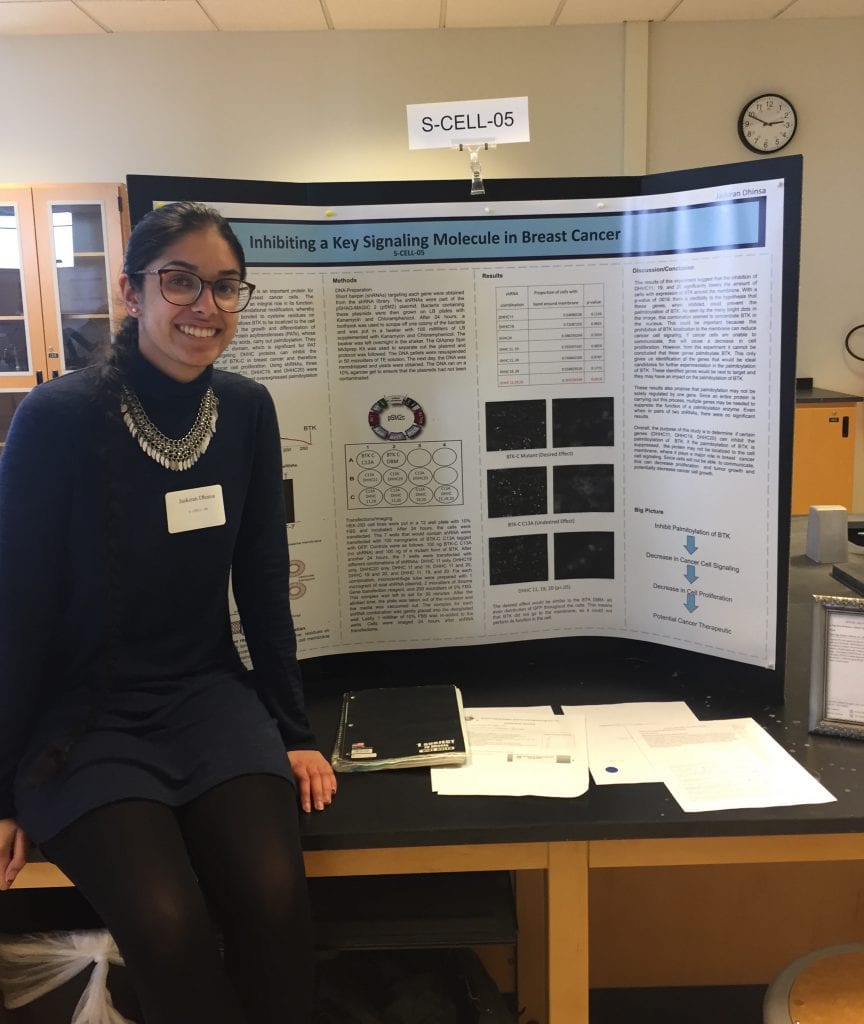BETHLEHEM — Jaskiran Dhina, a senior at Bethlehem Central High School, has spent almost three years working to inhibit a signaling molecule in breast cancer. Last month, she presented some of her findings to a panel of scientists and engineers at the Greater Capital Region Science and Engineering Fair at Rensselaer Polytechnic Institute in Troy, where her research work and presentation earned her the Science Fair’s Regeneron Health Award.
Of more than 100 research projects presented at the Science Fair, biotechnology giant Regeneron identified Dhinsa’s project as the one demonstrating the most creativity in improving or identifying health issues.
“It was pretty exciting,” said Dhinsa. “They told me that after college I should come back to work for them.”
Dhinsa, known to her friends as Kiran, is part of the Science Research program at the high school. She began her breast cancer research at the University of Albany Cancer Research Center in Rensselaer in the summer of 2015. There, she has been working under the guidance of researcher Dr. Douglas Conklin, who serves as Dhinsa’s mentor and leads a team of researchers who are using a process called palmitoylation to indirectly inhibit a signaling molecule in breast cancer.
The research is intended to help scientists better understand breast cancer tumor biology so targeted therapies could be developed to improve treatments and outcomes in patients.
“As part of the Science Research program, Kiran was already connected with a researcher, Dr. Conklin,” said Science Department Director Jennifer Gonyea, who noted that the science fair encourages students to work with mentors and conduct research. “Science Research gives students interested in STEM subject areas real-world opportunities to explore careers, such as science and medicine, up close.”
The Science Research course at BCHS is intended to be a two- to three-year program. In year one, students choose a research topic and are taught required skills and methods for conducting original research. Research topics may come from mathematics, physical sciences, life sciences, social sciences or psychology.
At the end of the first year, students are required to seek a scientist mentor to guide them. Students are expected to finalize a research topic by the end of sophomore year and begin research during the summer and continuing into the junior year. For third year Science Research students, senior year is used for writing the research and presenting it at science competitions, like the one at RPI.
The Greater Capital Region Science and Engineering Fair, in its 27th year, showcases student research in science, technology, engineering, and math (STEM).
“It is one of the top science fairs in New York state, attracting students from the Capital Region and beyond,” said Gonyea. “What sets this science fair apart is that students must come up with their own research topic. They are not allowed to search the Internet for a project and simply demonstrate it as part of their presentation. They must be fully, and independently, invested in original research.”
Dhinsa said when she began the Science Research course in her sophomore year, she was initially interested in researching skin cancer but had a hard time finding skin care research being done in the Capital Region. So she turned her attention to breast cancer and found a home in the state-of-the-art labs at the Cancer Research Center.
“At first, it was really intimidating being in the lab,” said Dhinsa, who was the only high school student there last summer. “I slowly kept watching the work that was being done and soon I became more comfortable. I am looking forward to going back this summer to try to prove some of the findings we had in some of our preliminary trials.”
Dhinsa will graduate in June and looks forward to studying public health and eventually attending medical school. She said Bethlehem’s Science Research program has provided some unique opportunities for her to explore her interests while still in high school.
“In year one, there are about eight presentations you are required to give and these help you with confidence and skills that can be used anywhere,” she said. “What I really like is the independence you have in years two and three, when you meet with your teacher every two weeks to discuss your research work. That kind of independence helps prepare you for working in a lab environment.”



